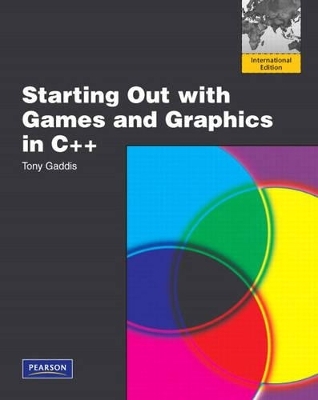
Starting Out with Games and Graphics in C++
Pearson
978-0-321-61045-4 (ISBN)
- Titel erscheint in neuer Auflage
- Artikel merken
In Starting Out with Games and Graphics in C++, Gaddis covers the essentials of programming for a novice using the C++ language. Like all Gaddis books, it covers each and every step. Throughout the book, programming topics are illustrated with graphical examples, including full chapter long case studies that implement simple, but complete, video games. This approach insures that students remain motivated by the material, while still getting a solid CS1 foundation. Only enough game- and graphics-theory is covered for students to understand the examples.
Tony Gaddis is the principal author of the Starting Out with series of textbooks. He has nearly two decades of experience teaching computer science courses, primarily at Haywood Community College. Tony is a highly acclaimed instructor who was previously selected as the North Carolina Community College Teacher of the Year, and has received the Teaching Excellence award from the National Institute for Staff and Organizational Development. The Starting Out with series includes introductory textbooks covering Programming Logic and Design, Alice, C++, Java, Microsoft Visual Basic, and Python.
Chapter 1: Introduction to Computers and Programming
1.1 Introduction
1.2 Hardware
1.3 How Computers Store Data
1.4 How a Program Works
1.5 C++ and the Dark GDK Library
Chapter 2: Graphics Programming with C++ and the Dark GDK Library
2.1 Getting Your Feet Wet with the Dark GDK Library
2.2 The Screen Coordinate System
2.3 Basic 2D Shapes
2.4 Displaying Text
2.5 In the Spotlight: The Orion Constellation Program
2.6 The Program Development Cycle
Chapter 3: Variables, Calculations, and Colors
3.1 Introduction
3.2 Literal Data
3.3 Variables
3.4 Calculations
3.5 In the Spotlight: Drawing Simple Bar Charts
3.6 Getting Values from Functions
3.7 Colors
3.8 In the Spotlight: Drawing the Italian Flag
3.9 Named Constants
Chapter 4: void Functions
4.1 Modularizing a Program with Functions
4.2 Defining and Calling a void Function
4.3 Designing a Program to Use Functions
4.4 Local Variables
4.5 Passing Arguments to Functions
4.6 Global Variables and Constants
Chapter 5: Working with Images
5.1 Introduction
5.2 Bitmaps
5.3 Images and Transparency
Chapter 6: Control Structures
6.1 Introduction
6.2 Single-Alternative Decision Structures: The if Statement
6.3 Dual-Alternative Decision Structures: The if-else Statement
6.4 Nested Decision Structures and the if-else-if Statement
6.5 Repetition Structures: The while Loop and the do-while Loop
6.6 The Increment and Decrement Operators
6.7 Repetition Structures: The for Loop
6.8 Using the for Loop to Process Pixels in an Image
6.9 Logical Operators
6.10 The switch Statement
6.11 Numeric Truth, Flags, and bool Variables
Chapter 7: The Game Loop and Animation
7.1 The Game Loop
7.2 Simple Animation
7.3 Controlling Objects with the Keyboard
7.4 Sprites
7.5 Cel Animation and Sprite Sheets
7.6 Sprite Collision Detection
Chapter 8: The Vulture Trouble Game: Introducing Audio, Physics, and Text Effects
8.1 Introduction
8.2 Playing Sound Effects and Music
8.3 Simulating Falling Objects
8.4 Text Effects
8.5 The Vulture Trouble Game
Chapter 9: Value-Returning Functions and Mouse Input
9.1 Writing a Value-Returning Function
9.2 Working with the Mouse
9.3 The Bug Zapper Game
Chapter 10: Arrays and Tile Mapping
10.1 Array Basics
10.2 Sorting Arrays
10.3 Two-Dimensional Arrays
10.4 Tile Maps
Chapter 11: Strings and Files
11.1 Working with Strings
11.2 Introduction to File Input and Output
11.3 Saving a Game's High Score
Chapter 12: Object-Oriented Programming
12.1 Procedural and Object-Oriented Programming
12.2 Classes and Objects
12.3 An Object-Oriented Game: Balloon Target
12.4 Inheritance
Appendix A: Downloading and Installing the Required Software
Appendix B: The ASCII Character Set
Online:
Case Study: Scones McNabb
Case Study: Object-Oriented Vulture Trouble
| Erscheint lt. Verlag | 23.7.2009 |
|---|---|
| Sprache | englisch |
| Maße | 254 x 203 mm |
| Gewicht | 1314 g |
| Themenwelt | Mathematik / Informatik ► Informatik ► Programmiersprachen / -werkzeuge |
| Informatik ► Software Entwicklung ► Objektorientierung | |
| ISBN-10 | 0-321-61045-8 / 0321610458 |
| ISBN-13 | 978-0-321-61045-4 / 9780321610454 |
| Zustand | Neuware |
| Haben Sie eine Frage zum Produkt? |
